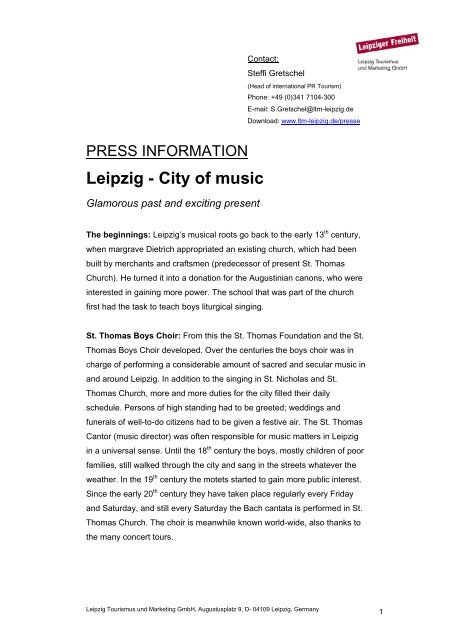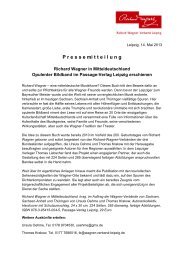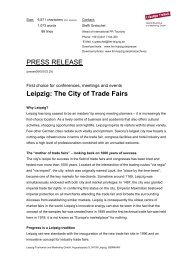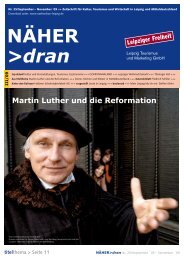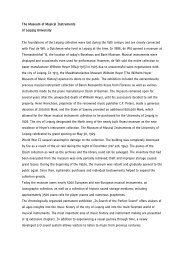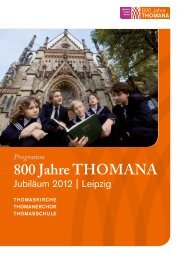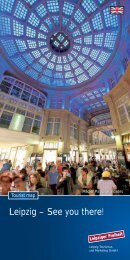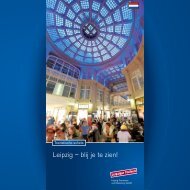Leipzig - City of music
Leipzig - City of music - Leipzig Tourismus und Marketing GmbH
Leipzig - City of music - Leipzig Tourismus und Marketing GmbH
- No tags were found...
You also want an ePaper? Increase the reach of your titles
YUMPU automatically turns print PDFs into web optimized ePapers that Google loves.
Contact:<br />
Steffi Gretschel<br />
(Head <strong>of</strong> international PR Tourism)<br />
Phone: +49 (0)341 7104-300<br />
E-mail: S.Gretschel@ltm-leipzig.de<br />
Download: www.ltm-leipzig.de/presse<br />
PRESS INFORMATION<br />
<strong>Leipzig</strong> - <strong>City</strong> <strong>of</strong> <strong>music</strong><br />
Glamorous past and exciting present<br />
The beginnings: <strong>Leipzig</strong>’s <strong>music</strong>al roots go back to the early 13 th century,<br />
when margrave Dietrich appropriated an existing church, which had been<br />
built by merchants and craftsmen (predecessor <strong>of</strong> present St. Thomas<br />
Church). He turned it into a donation for the Augustinian canons, who were<br />
interested in gaining more power. The school that was part <strong>of</strong> the church<br />
first had the task to teach boys liturgical singing.<br />
St. Thomas Boys Choir: From this the St. Thomas Foundation and the St.<br />
Thomas Boys Choir developed. Over the centuries the boys choir was in<br />
charge <strong>of</strong> performing a considerable amount <strong>of</strong> sacred and secular <strong>music</strong> in<br />
and around <strong>Leipzig</strong>. In addition to the singing in St. Nicholas and St.<br />
Thomas Church, more and more duties for the city filled their daily<br />
schedule. Persons <strong>of</strong> high standing had to be greeted; weddings and<br />
funerals <strong>of</strong> well-to-do citizens had to be given a festive air. The St. Thomas<br />
Cantor (<strong>music</strong> director) was <strong>of</strong>ten responsible for <strong>music</strong> matters in <strong>Leipzig</strong><br />
in a universal sense. Until the 18 th century the boys, mostly children <strong>of</strong> poor<br />
families, still walked through the city and sang in the streets whatever the<br />
weather. In the 19 th century the motets started to gain more public interest.<br />
Since the early 20 th century they have taken place regularly every Friday<br />
and Saturday, and still every Saturday the Bach cantata is performed in St.<br />
Thomas Church. The choir is meanwhile known world-wide, also thanks to<br />
the many concert tours.<br />
<strong>Leipzig</strong> Tourismus und Marketing GmbH, Augustusplatz 9, D- 04109 <strong>Leipzig</strong>, Germany<br />
1
Johann Sebastian Bach: Bach had not been the city council <strong>of</strong> <strong>Leipzig</strong>’s<br />
first choice for the position <strong>of</strong> St. Thomas Cantor. He only got the job after<br />
Georg Phillip Telemann (who had been by far more famous then) and the<br />
composer Johann Christoph Graupner had turned it down. From 1723 until<br />
his death in 1750 Bach was responsible for the church services and special<br />
church festivities at St. Nicholas and St. Thomas. Additionally, as director<br />
<strong>music</strong>es <strong>of</strong> the city, he was in charge <strong>of</strong> a number <strong>of</strong> worldly affairs. For<br />
several years he was head <strong>of</strong> the collegium <strong>music</strong>um, a group <strong>of</strong><br />
pr<strong>of</strong>essional and student <strong>music</strong>ians. He was also asked to examine organs<br />
in numerous towns and cities, where he then presented his virtuous<br />
abilities. Many important works <strong>of</strong> the great St. Thomas Cantor were written<br />
in <strong>Leipzig</strong>: among them several cantata series, St. John and St. Matthew<br />
Passion, the Christmas Oratorio, the Art <strong>of</strong> the Fugue and the Mass in B-<br />
Minor. Since the 19 th century <strong>Leipzig</strong> has been the centre <strong>of</strong> comprehensive<br />
efforts to explore and interpret the works <strong>of</strong> Bach. In this context a number<br />
<strong>of</strong> institutions were founded. Some facts: 1900 founding <strong>of</strong> the New Bach<br />
Society, 1950 founding <strong>of</strong> the Bach Archives, 1964 start <strong>of</strong> the biannual<br />
International Johann Sebastian Bach Competitions, 1999 start <strong>of</strong> the Bach<br />
Festival <strong>Leipzig</strong>.<br />
Music Theatre: During the Easter Fair in 1693, the first <strong>Leipzig</strong> opera<br />
house was opened, located on Brühl. The twenty year old Georg Phillip<br />
Telemann was responsible for the first big success <strong>of</strong> the <strong>music</strong> theatre.<br />
The catchy and popular character <strong>of</strong> his compositions attracted a big<br />
audience. In 1868 the New Theatre on Augustusplatz was opened. Works<br />
by Carl Maria von Weber (”Freischütz”), Louis Spohr (”Jessonda”) and<br />
Albert Lortzing (”Zar und Zimmermann”) contributed to the development <strong>of</strong><br />
”grand opera” in <strong>Leipzig</strong>. Angelo Walther, director <strong>of</strong> the opera between<br />
1876 and 1882, was a great supporter <strong>of</strong> Richard Wagner’s <strong>music</strong>. He<br />
produced the first complete performance <strong>of</strong> ”Ring der Nibelungen” after<br />
Bayreuth. Between 1923 and 1933 the repertoire was very ambitious,<br />
despite restricting conventions. New works resulted in much talked about<br />
first nights. The first night <strong>of</strong> Ernst Krenek’s ”Jonny spielt auf” (1927) and<br />
Kurt Weill’s ”Aufstieg und Fall der Stadt Mahagonny” (1930) were among<br />
the most spectacular events <strong>of</strong> the century.<br />
<strong>Leipzig</strong> Tourismus und Marketing GmbH, Augustusplatz 9, D- 04109 <strong>Leipzig</strong>, Germany<br />
2
Gewandhaus: After 1740 the first concert enterprises came into being.<br />
They arranged <strong>music</strong>al events for experts and friends <strong>of</strong> classical <strong>music</strong><br />
against a fee. From this the later Gewandhaus concerts developed. They<br />
were named after the hall in the former cloth-makers guild house, which<br />
was inaugurated in 1781. This concert venue, the Gewandhaus, became a<br />
Mecca for famous artists. Works by Robert Schumann, Johannes Brahms,<br />
Franz Liszt, Peter Tchaikovsky and numerous others were part <strong>of</strong> the<br />
programme and either enthusiastically welcomed or mercilessly booed at<br />
by the well-to-do <strong>Leipzig</strong> audience.<br />
The Gewandhaus <strong>music</strong> directors – among them Johann Adam Hiller, Felix<br />
Mendelssohn Bartholdy, Arthur Nikisch, Wilhelm Furtwängler and Kurt<br />
Masur – influenced the repertoire and interpretation pr<strong>of</strong>iles differently.<br />
Already in the 19 th century the Gewandhaus Orchestra was involved in<br />
<strong>Leipzig</strong>’s <strong>music</strong>al life in three ways: Beside its own concerts it was in<br />
charge <strong>of</strong> the <strong>music</strong> in the opera and also accompanied the St. Thomas<br />
Boys Choir – a peculiarity which has survived until today. As an institution<br />
in a comprehensive sense the Gewandhaus is now a place for the arts with<br />
concerts, symposia and exhibitions.<br />
Conservatory: Since the beginnings <strong>of</strong> <strong>music</strong>al life in <strong>Leipzig</strong> there has<br />
hardly been anything more important than taking care <strong>of</strong> the new<br />
generation <strong>of</strong> <strong>music</strong>ians. Pedagogic efforts were connected with St.<br />
Thomas School and the work <strong>of</strong> important composers and virtuosi. The city<br />
pipers had their trainees. In the 19 th century the establishing <strong>of</strong> an efficient<br />
art institute became more and more urgent. It was Mendelssohn, however,<br />
who succeeded in organising an educational institute that met the most<br />
modern requirements: On 2 nd April, 1843 the ”Conservatory <strong>of</strong> Music”<br />
opened its gates with six teachers and 22 alumni. Renowned artists –<br />
beside Mendelssohn also Robert Schumann and Moritz Hauptmann – were<br />
in charge <strong>of</strong> teaching. From the beginning a close relationship with the<br />
Gewandhaus developed. In 1919 an institute for church <strong>music</strong> was founded<br />
at the conservatory, which is now the College <strong>of</strong> Music and Drama. The<br />
church <strong>music</strong> institute was reopened in 1992.<br />
Music publishing houses: <strong>Leipzig</strong>’s reputation as a city <strong>of</strong> <strong>music</strong> was to a<br />
large degree based on the <strong>music</strong> publishing houses, many <strong>of</strong> which used to<br />
be in the city. The annual trade fairs had always <strong>of</strong>fered favourable<br />
conditions for the trade with <strong>music</strong>al notations and instruments. The latest<br />
<strong>Leipzig</strong> Tourismus und Marketing GmbH, Augustusplatz 9, D- 04109 <strong>Leipzig</strong>, Germany<br />
3
compositions were available in <strong>Leipzig</strong>. This was certainly not the least<br />
important reason why <strong>music</strong> from all over the world went to <strong>Leipzig</strong>.<br />
Renowned composers had their <strong>music</strong> printed in <strong>Leipzig</strong>. The tradition <strong>of</strong><br />
the much sought-after <strong>Leipzig</strong> <strong>music</strong>al prints is connected with the<br />
development <strong>of</strong> famous enterprises: foundation <strong>of</strong> <strong>music</strong> publishing house<br />
(since 1796 Breitkopf & Härtel), 1807 opening <strong>of</strong> a <strong>music</strong> shop by Friedrich<br />
H<strong>of</strong>meister, which was soon complimented by a publishing house.<br />
Complete editions, e g. <strong>of</strong> Bach, Mozart and Mendelssohn as well as<br />
numerous first editions came from <strong>Leipzig</strong> publishing houses. But not only<br />
<strong>music</strong>al notations, also thousands <strong>of</strong> books on <strong>music</strong> and renowned<br />
magazines (”Neue Zeitschrift für Musik” / New Magazine <strong>of</strong> Music)<br />
originated from <strong>Leipzig</strong>.<br />
Great variety: <strong>Leipzig</strong>’s daily <strong>music</strong>al life knows many facets. You need not<br />
go into the Gewandhaus, opera or churches to find traces <strong>of</strong> <strong>music</strong>al<br />
culture in <strong>Leipzig</strong>. Everyday life can be experienced in the streets and<br />
squares or city arcades, where street <strong>music</strong>ians provide spontaneous<br />
entertainment. The great variety on <strong>of</strong>fer makes <strong>Leipzig</strong> a city worth seeing<br />
and hearing on 365 days a year.<br />
Music festival: Each year in June the <strong>Leipzig</strong> Bach Festival is held. During<br />
this important international festival renowned <strong>music</strong>ians from all over the<br />
world present a program at authentic Bach sites. The programme includes<br />
<strong>music</strong> from the 17th century until the present day.<br />
<strong>City</strong> walks: The <strong>Leipzig</strong> city guides have developed theme tours like<br />
”<strong>Leipzig</strong> – <strong>City</strong> <strong>of</strong> Music” and ”In the Footsteps <strong>of</strong> Bach”, which present<br />
<strong>Leipzig</strong>’s great <strong>music</strong>al variety in an entertaining way. Bookings on phone:<br />
+49-341-7104-230, Fax: +49-341-7104-231<br />
Information on <strong>Leipzig</strong>:<br />
<strong>Leipzig</strong> Tourismus und Marketing GmbH,<br />
Tourist Information: Katharinenstr. 8, D - 04109 <strong>Leipzig</strong>, Tel. +49 (0)341/7104-265,<br />
info@ltm-leipzig.de, www.ltm-leipzig.de<br />
<strong>Leipzig</strong> Tourismus und Marketing GmbH, Augustusplatz 9, D- 04109 <strong>Leipzig</strong>, Germany<br />
4
<strong>Leipzig</strong>’s famous <strong>music</strong> places:<br />
1) St. Nicholas Church: In 1213 the city and parish church St. Nicholas<br />
was first mentioned in a document. As the starting point <strong>of</strong> the Monday<br />
Demonstration in the autumn <strong>of</strong> 1989 the church is one <strong>of</strong> the city’s bestknown<br />
buildings. The four-manual concert organ built in 1859 is still one <strong>of</strong><br />
Germany’s biggest. (address: Nikolaikirchh<strong>of</strong> 3, D-04109 <strong>Leipzig</strong> – phone:<br />
+49-341-960 5270)<br />
2) <strong>Leipzig</strong> Opera: The hour <strong>of</strong> birth for <strong>Leipzig</strong>’s opera had already come in<br />
1693, which makes it the third-oldest European opera house after Milan<br />
and Hamburg. The opera house on Augustusplatz was opened in 1960 with<br />
a performance <strong>of</strong> Wagner’s ”Meistersinger von Nürnberg”. (address:<br />
Augustusplatz 12, D-04109 <strong>Leipzig</strong> – phone: +49-341-126 1261)<br />
3) Richard Wagner Monument: The column put up in 1983 at the pond<br />
next to the opera house carries a bronze cast <strong>of</strong> the marble bust created by<br />
Max Klinger. Wagner is a son <strong>of</strong> the city. He was born here on 22 nd May,<br />
1813. A memorial plaque at the Horten department store reminds <strong>of</strong><br />
Richard Wagner’s house <strong>of</strong> birth, which had to give way to new buildings in<br />
1886.<br />
4) Museum <strong>of</strong> Musical Instruments: The museum owns a comprehensive<br />
collection <strong>of</strong> instruments from European workshops from the Middle Ages<br />
up to the present time. The exhibition is housed in the northern wing <strong>of</strong> the<br />
GRASSI Museum and comprises 5,000 pieces. The most important exhibit<br />
is the world’s oldest intact piano forte. (address: Täubchenweg 2c, D-04103<br />
<strong>Leipzig</strong> – phone: +49-341-214 2120)<br />
5) Mendelssohn House: The house in Golschmidtstrasse 12, which has<br />
meanwhile been refurbished, was Felix Mendelssohn’s <strong>Leipzig</strong> address.<br />
From 1835 until his death in 1847 he lived in <strong>Leipzig</strong>. His study and the<br />
drawing room, in which beside Wagner also Schumann and Berlioz were<br />
guests, have been restored in their original form. The Mendelssohn House<br />
is the only house world-wide that commemorates the great composer’s and<br />
Gewandhaus <strong>music</strong> director’s life and work. (address: Goldschmidtstrasse<br />
12, D-04103 <strong>Leipzig</strong> – phone: +49-341-127 0294)<br />
<strong>Leipzig</strong> Tourismus und Marketing GmbH, Augustusplatz 9, D- 04109 <strong>Leipzig</strong>, Germany<br />
5
6) Robert Schumann Monument: The monument was a donation <strong>of</strong> a<br />
<strong>Leipzig</strong> <strong>music</strong> fan and put up sixteen years after Schumann’s death.<br />
Schumann came to <strong>Leipzig</strong> as a student in 1828. In the year <strong>of</strong> his wedding<br />
with Clara Wieck he wrote about 150 songs for piano. In 1834 he founded<br />
the New Magazine for Music. (address: Schillerstrasse, behind Moritzbastei<br />
students club)<br />
7) Schumann House: The home <strong>of</strong> Robert and Clara Schumann in <strong>Leipzig</strong><br />
(1840-1844) is an architectural gem. The young couple moved into the<br />
house after their wedding in the church <strong>of</strong> Schönefeld on 12 th September,<br />
1840. (address: Inselstrasse 6, D-04103 <strong>Leipzig</strong> – phone: +49-341-393<br />
9120)<br />
8) Gewandhaus concert hall: The so-called New Gewandhaus concert<br />
hall, which was opened in 1981 thanks to the commitment <strong>of</strong> Kurt Masur,<br />
can boast <strong>of</strong> an outstanding acoustics and has gained an excellent<br />
reputation world-wide due to the Gewandhaus Orchestra and the<br />
Gewandhaus <strong>music</strong> directors. About 200 <strong>music</strong>ians contribute to the<br />
ensemble’s success. The Gewandhaus Quartet founded in 1809 is, by the<br />
way, the world’s oldest civic string quartet. The history <strong>of</strong> the Gewandhaus<br />
began with the Grosse Concert, a group <strong>of</strong> 16 <strong>music</strong>ians, founded by<br />
<strong>Leipzig</strong> citizens in 1743. (address: Augustusplatz 8, D-04109 <strong>Leipzig</strong> –<br />
phone: +49-341-12780)<br />
9) St. Thomas Church: Built in 1212, St. Thomas Church is still a centre <strong>of</strong><br />
church and <strong>music</strong> life and had been Bach’s working place for many years.<br />
The great composer’s sarcophagus has been inside the choir <strong>of</strong> the church<br />
since 1950. (address: Thomaskirchh<strong>of</strong> 18, D-04109 <strong>Leipzig</strong> – phone: +49-<br />
341-960 2855)<br />
10) Old Bach Monument: The monument, which was a donation <strong>of</strong> Felix<br />
Mendelssohn, was unveiled in 1843. (address: park at Dittrichring, near St.<br />
Thomas’)<br />
<strong>Leipzig</strong> Tourismus und Marketing GmbH, Augustusplatz 9, D- 04109 <strong>Leipzig</strong>, Germany<br />
6
11) New Bach Monument: The second monument to Bach is a 2.45<br />
metres high bronze statue created in 1908. It was drafted by Carl Seffner.<br />
(address: Thomaskirchh<strong>of</strong>, next to St. Thomas’s)<br />
12) Bach Archive and Bach Museum: The permanent exhibition ”Bach in<br />
<strong>Leipzig</strong>” gives an insight into Bach’s life, work and influence on the further<br />
<strong>music</strong>al development in <strong>Leipzig</strong>. (address: Thomaskirchh<strong>of</strong> 15/16, D-04109<br />
<strong>Leipzig</strong> – phone: +49-341-964410)<br />
<strong>Leipzig</strong> Tourismus und Marketing GmbH, Augustusplatz 9, D- 04109 <strong>Leipzig</strong>, Germany<br />
7


